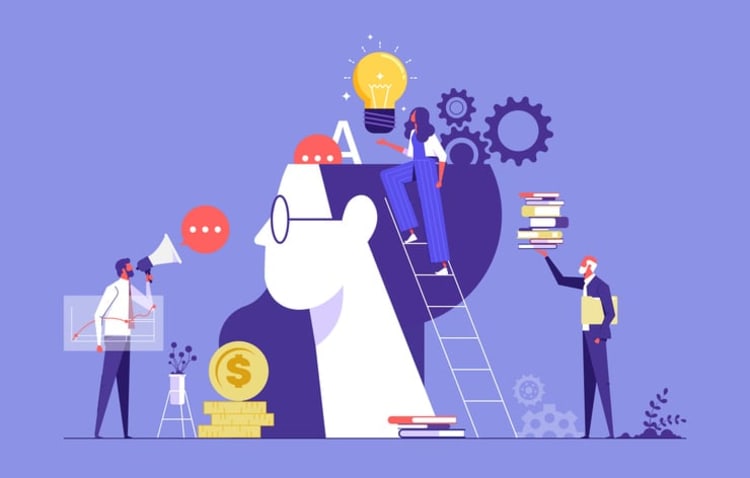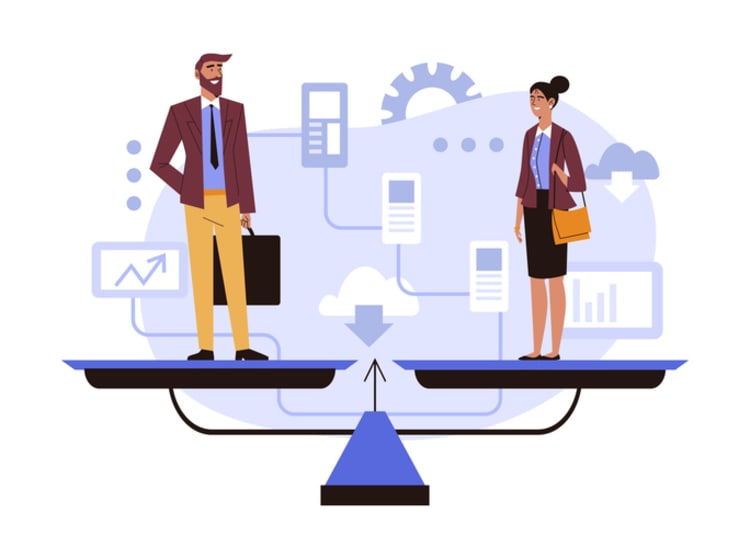A few years back, almost every business branded itself "customer-centric." The term employee experience (EX) was barely in the picture. Fast forward to today, the EX movement has significantly gained momentum — almost all organizations are becoming "employee-obsessed."
So, why has employee experience become such a forefront topic? What does it mean? How important is it? How can you improve it?
What is employee experience?
Employee experience is how workers perceive interactions with their employer. It encompasses everything an employee sees, observes, or learns throughout their employment journey — from candidacy to recruitment, onboarding, work period, and exit.
Satisfactory employee experience is essential to business performance. And reasonably so — creating a solid brand, enhancing customer experience, developing competitive products, and almost all foundational aspects of business performance depend on employees.
Employees with a positive EX usually work harder and are more invested in enhancing their organization's operational performance. On the other hand, employees with a negative EX are likely to become demotivated and less productive.

Components of employee experience
Employee experience is a broad concept with several components. However, most of these fall into three major categories:
1. Environment
The physical environment is what employees see, smell, touch, or taste within an organization's workspace. Examples include the office floor plan, indoor plants, art hanging on the walls, on-site gym, cafeteria, or lounge area. It also covers the demographics of other workers, including their ages, genders, or racial diversities.
The state of an organization's environment, whether in a physical or virtual office, can significantly influence employees' morale, engagement, and productivity. For example, an open floor-plan office with picture windows can energize the workplace and encourage employee collaboration. The more inspiring workers find their office environments, the more they will enjoy their tasks, subsequently enhancing productivity.
2. Technological tools
The technological components of EX refer to the tools employees use to perform tasks. These include approved mobile gadgets, a company's internal social network, CRM systems, desktops, laptops, networking devices, and productivity tools. They also comprise e-learning systems, design elements, and other applications that affect how workers use various technologies.
When employees use outdated or poorly designed technologies, they usually get frustrated. For instance, if a worker must wait several minutes to print two or three pages that a modern printer could have done in a few seconds, they are likely to feel demotivated.
Ineffective technological tools also reduce employees' productivity, making them feel helpless and disengaged. Comparatively, modern technologies can simplify staff duties, boost morale, and expedite business operations.
Besides investing in the best technologies, organizations should ensure their workforce has the requisite skills to handle these tools. Otherwise, installing complex technological equipment that workers can't operate will also lead to employee frustration and a negative employee experience.
3. Organizational culture
An organization's culture refers to its values, principles, attitudes, mission, and practices. Some say, "It's what happens when the CEO isn't around." Others believe it's the traditions that the manager and other executives propagate.
Regardless of your definition of organizational culture or perception of who controls it, one thing is constant — culture is about the feeling or "vibe" a workplace radiates. It usually depends on a company's structure and leadership style and significantly influences employee morale.
A positive organizational culture energizes employees and makes their workplace experience enjoyable. Comparatively, a negative culture can drain, "suffocate," and demotivate employees.

Benefits of employee experience
Positive employee experience results in a motivated workforce, which comes with the following benefits:
- Increased employee engagement: Employees with a positive workplace experience don't just come to work because they need to "put in the time" to earn their salaries. Instead, they enjoy and become more invested in their tasks and projects, leading to higher engagement.
- Higher productivity and innovation: A positive EX breeds a motivated workforce constantly seeking ways to enhance their organization's processes and performance. As a result, the employees will be more productive and innovative.
- Improved retention: In a world where monetary compensation is no longer the primary motivator for employees, employee experience plays a crucial role in employee retention. According to Gallup, strong employee engagement can reduce employee turnover by 59%.
- High-quality workers: Before applying for a position with a company, candidates typically look into the company's work culture, reputation, and employee reviews. A company with a favorable EX reputation will likely attract a number of qualified applicants.
- An enhanced customer experience (CX): Employees often project their feelings towards an organization to clients. A motivated workforce will likely be present and productive and serve customers more effectively, enhancing the company's customer experience.
- Higher job satisfaction: Imagine going to work every day in an environment that makes you uncomfortable and using outdated tools that make your job even more frustrating. When an organization invests in employee experience, it eliminates these frustrations, enabling employees to enjoy their work — resulting in higher job satisfaction.
- Increased revenue: Research shows that companies that take EX and employee engagement seriously increase their profitability by about 23%. That's because positive EX results in more engaged and productive employees.

Digital employee experience
Digital experience (DEX) comprises all aspects of employees' interactions with an organization's technologies. It's essential in delivering EX, especially with the continual increase in remote and hybrid work environments.
Role of technology in employee experience
Below are a few aspects of EX that technology can help improve:
- Teamwork: Collaboration tools like Slack, Skype, Google Drive, Dropbox, and Trello, paired with virtual office tools like Kumospace, make it easy for employees to work on projects jointly without necessarily being physically together. They eliminate unnecessary travel, enhancing EX.
- Connectivity: There's no denying that almost every business is moving towards a remote or hybrid workforce. Technology makes it easy for employees to carry work home and complete tasks from anywhere, making them more engaged.
- Productivity: An organization that invests in technology empowers its workforce to automate routine tasks, allowing them to focus more on productivity-oriented projects.
Digital tools and their impact on employee satisfaction
Digital tools can help organizations create a collaborative workforce and foster an open communication environment that enables employees to connect with colleagues and have a voice within the company. They allow workers to communicate freely with executives and colleagues on what works and identify areas requiring adjustments. The more employees feel their inputs matter in an organization, the more they immerse in its processes, enhancing their morale.
Implementing user-friendly and effective digital solutions
As mentioned above, deploying the latest technologies is only beneficial if the workforce can handle them. Otherwise, doing so will frustrate the employees and lower EX.
Before installing any technological tool, executives should ensure their employees are conversant with it. If employees lack the requisite skills, the company should organize training sessions.
Another factor to consider is employees' perspective towards the tool. Digital transformation can only be effective if workers embrace it. Organizations should ensure all the technologies they implement are user-friendly, easy to navigate, and adaptable to employees' needs.

Employee experience management
Employee experience management involves designing and implementing strategies to enhance employee experience. Several organizations have employee experience managers domiciled within their HR departments.
Strategies for improving employee experience
Below are some strategies organizations often use to improve their employee experience:
1. Regular feedback and communication
Employees usually feel motivated in workplaces where business owners and managers take their concerns seriously. Therefore, organizations can enhance EX by encouraging a culture of open communication. For example, executives can have regular sit-downs with employees on how to improve business processes.
2. Recognition and reward programs
Research by SurveyMonkey shows that approximately 82% of employees consider reward and recognition essential for job satisfaction. A similar study by SHRM Foundation found that over 91% of HR professionals believe reward programs boost staff morale and increase staff retention. Simply put, employees are likelier to have a positive EX in organizations that recognize and appreciate their efforts.
3. Learning and developing opportunities
There's a widespread misconception that organizations investing in their employees' learning and development usually lose them to higher-paying companies. However, research shows staff training reduces turnover by 30-50%. Employees often stick with companies that value their personal and professional development. As training is a significant factor for staff members, it can affect their perception of a company and its EX.

Measuring and analyzing employee experience
Organizations can measure and analyze their EX in the following ways:
1. Employees surveys and feedback tools
Companies can design surveys to gauge employees' perceptions of their organization and processes. They can also ask staff members to submit ideas for improving the workspace through suggestion boxes, open forums, or online feedback tools. Based on the employees' responses, executives can gauge the following:
- Whether staff members think they're helpful to the organization
- Employees' satisfaction levels with the available resources
- The comfort of the work environment
- Staff satisfaction with their salaries and compensation
- Areas that employees require improvements
2. Key performance indicators (KPIs) and metrics
If you're unsure of where to begin when evaluating EX, below are five KPIs you can check:
- Staff satisfaction levels
- Employee Net Promoter Score — The likelihood of employees recommending their employer to others
- Employee productivity
- Staff Retention rates
- Frequency of employee absenteeism

Case studies
Below are examples of companies that are reaping big benefits from investing in employee experience:
Gravity payments
This company came into the limelight in 2015 when Dan Price, its CEO, took a pay cut to raise employees' salaries. This controversial move became so popular that Harvard Business School took it as a case study. It increased the firm's customer inquiries, tripled Gravity Payments' revenues, and reduced staff turnover.
NVIDIA
Besides its fame for graphics cards, NVIDIA is renowned for its work culture. The tech giant is workforce-centric, with a family-first approach for staff members, financial refresher courses for employees, flexible work hours, and several community volunteering opportunities. That explains why it has a 93% employee net promoter score on Glassdoor.

Employee experience is essential for today's businesses
As you must have gathered, employee experience is not a luxury that organizations can choose to take seriously or ignore — it's an essential investment. Any company that doesn't invest in EX risks attracting fewer, less qualified employees and suffering high staff turnover rates. And without a competitive workforce, everything — from product design to production, marketing, sales, and customer relationship management — will derail.
FAQs on employee experience
Employee experience refers to how employees perceive their interactions with an employer, while employee engagement refers to how much employees invest their energies into an organization's projects.
Technology can help employees simplify and automate processes, making tasks more enjoyable and efficient.
First, employee experience is subjective — an experience that one employee considers positive might be negative to somebody else. Second, EX is not easy to measure and quantify.
You can use employee surveys and feedback tools or monitor key performance indicators and metrics.
A positive EX results in a more productive and motivated workforce, enhancing business performance.





